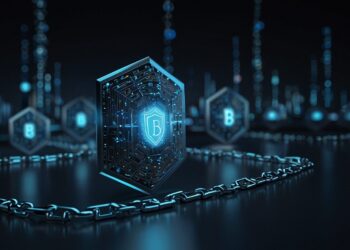A walkthrough for newcomers to the BNB Chain, also known as the evolution of the Binance Smart Chain
BNB Chain is the new name for what was formerly known as the Binance Smart Chain (BSC). Recently, the layer-1 blockchain of the cryptocurrency exchange Binance, known as BSC, made an announcement regarding the merger of the Binance Smart Chain and the Binance Chain to create the BNB Chain. The relaunch of Binance’s layer-1 blockchain, also known as the base blockchain, is a part of an overall plan to connect it to the protocol’s governance token, known as BNB, in order to expand decentralization and build upon it.
According to Changpeng Zhao, the CEO of Binance, “People always think of BSC as being part of Binance because it carries the company’s name.” He continued by saying, “We’ve put in a lot of work to decentralize it, and we hope to make BNB go beyond Binance.”
To date, Binance has invested more than one billion dollars in the BSC ecosystem. This is done to support the company’s ongoing and intensifying competition with the Ethereum network and other layer-1 blockchain systems. The goal of the effort is to satisfy those who have voiced concerns that the BSC is too centralized.
Binance has ambitions to position BNB as a token for the BSC ecosystem, which provides services to multiple industries, such as GameFi and the non-fungible token (NFT) market. This should help contribute to the importance of BNB in the eventual development of what Binance refers to as “MetaFi.”
What precisely is the BNB Chain?
In a tweet, Binance CEO Chanpeng Zhao explained that the abbreviation “BNB” stands for “Build the community, and let the community build, build, ‘n build.” According to Zhao, “Build ‘N Build” is an acronym for “Build ‘N Build.”
The recently distributed BNB Chain consists of the BNB Beacon Chain for BNB Chain governance (i.e., staking and voting) and the BNB Smart Chain, which is Ethereum Virtual Machine (EVM) compatible. Both chains were developed by the same team.
The BNB Chain is intended to improve interoperability and develop the underlying infrastructure of the “world’s parallel virtual environment,” which is a step forward in the efforts that Binance has recently made toward MetaFi.
Users are given the assurance that the BNB Chain will be:
 What specifically is the Binance Smart Chain?
What specifically is the Binance Smart Chain?
Binance Chain is the name of the company’s initial blockchain development project. However, its programmability was limited in some respects. Binance Smart Chain was designed specifically to circumvent these problems. In order to facilitate the utilization of applications that are based on smart contracts, the blockchain network known as Binance Smart Chain was developed.
Users are able to take advantage of a situation in which the best of both worlds is available to them as a result of the concurrent operation of BSC and Binance’s native Binance Chain, which provides a high transaction capacity. Additionally, the Ethereum Virtual Machine was coded into BSC, which gives it the ability to run applications that are based on Ethereum.
The purpose of the platform was to make it possible for developers to build decentralized applications (DApps) and to assist users in managing their digital assets cross-chain in a manner that was both high-capacity and low-latency. As was previously mentioned, BSC was eventually transformed into the BNB chain. Continue reading to learn more about the development of the Binance Smart Chain.
Updates Made to the Binance Smart Chain
In the same year (2017) that Binance and BNB were launched, BSC was issued for the first time in 2018. BSC became more well-known concurrently with the rise of Binance. Around the same time that the DeFi movement was gaining momentum, BSC was established. As time went on and more people became interested in alternative financial solutions, an increase in the number of use cases for blockchain technology also occurred.
Since its initial launch, the BNB token, which is issued by Binance, is said to have undergone consistent development. In 2017, it was first introduced onto the Ethereum network as a token with the ERC-20 standard. By 2019, it had made the switch to the Binance Chain and was helping to fuel the establishment of the BSC network, which was officially launched the following year in September 2020.
As a result of the token’s growth on BSC, Binance now considers BNB to be the token for a greater ecosystem. This ecosystem includes both the Binance Chain and the BSC. This move is a component of the cryptocurrency giant’s overarching strategy to compete with Binance. The BNB token is now the standard for the BNB chain.
BNB vs. Binance Smart Chain
The Binance Chain, which is the location of activities such as staking and voting (BNB Chain Governance), has transitioned into the BNB Beacon Chain as part of the rebranding of the BNB Chain. Simply referred to as BNB Smart Chain, the Binance Smart Chain is compatible with the EVM and supports multiple blockchains. The Binance Smart Chain is still abbreviated as BSC.
Having said that, the BNB chain possesses its very own dynamic ecosystem, which it shares with the BSC. The basic idea behind BNB is that in the long run, absolutely everyone will own it; therefore, it is imperative that users have access to it. In addition, Binance Coin, which is now abbreviated to BNB, serves both as a governance token and as a means of payment for gas fees on the BNB chain.
Above all else, BNB Chain remains a decentralized, open-sourced, and community-driven ecosystem, the health of which is dependent on the assistance provided by its developers as well as the community of users, validators, and delegators. In addition to this, BNB Chain will support large-scale applications such as SocialFi, GameFi, and the Metaverse.
The Binance Coin (BNB) and the Binance ecosystem
BNB is the cryptocurrency that powers the BNB Chain ecosystem. It is also the native coin of both the BNB Beacon Chain and the BNB Smart Chain. The new meaning of the BNB token is “Build and Build.” In addition to acting as a fuel for transactions on the BNB Chain, it also fulfills the role of a governance token, in a manner analogous to that of Ethereum’s gas.
A participant needs to own BNB in order to take part in the decentralized on-chain governance of the BNB Chain. Along with the rebranding, additional developments to BNB have also been announced, including technical upgrades to realize decentralization even further. It is anticipated that the users, developers, and projects within the community will benefit from such enhancements.
Some of the upgrades that Binance has announced include the following:
• The development of a new protocol that is both verifiable and objective, known as the BNB auto-burn
• The v1.1.5. Upgrade to the hard fork of Bruno that resulted in an increased rate of BNB burning.
BNB can be traded on the Binance exchange just like any other cryptocurrency, and it can also be used in a variety of apps and use cases, such as paying for transaction fees made via the BNB Chain and purchasing goods and services both online and in-person.
The native BNB token, which drives the BEP-20 and BEP-2 token standards, makes it possible for the BNB Chain ecosystem to support interoperability thanks to its dual-chain architecture. But what exactly differentiates one from the other?
BEP-2 is the token standard used by the BNB Beacon Chain, whereas BEP-20 is the token regulation protocol used by the BSC. The BEP-20 token standard is frequently compared to Ethereum’s ERC-20 token because of the striking similarities between them in a variety of respects.
To summarize, the BEP-20 token standard is utilized in the production of cryptocurrency tokens for the BNB Smart Chain, whereas the BEP-2 standard is implemented for the BNB Beacon Chain.
BNB’s Aims and Objectives
Following the rebranding of the BSC, a number of enhancements were made accessible to users, owners of projects, and developers affiliated with the BNB Chain community. Large-scale applications such as Metaverse, GameFi, and SocialFi, along with a few others, will soon be incorporated into the BNB Chain.
The BNB chain also saw the following other significant improvements:
 Binance emphasized in their announcement that “the BNB Chain will continue to operate as a community-driven, open-source, and decentralized ecosystem.”
Binance emphasized in their announcement that “the BNB Chain will continue to operate as a community-driven, open-source, and decentralized ecosystem.”
How to use the BNB Chain
Binance insists that BNB is applicable to a wide variety of use cases, both within the BNB Chain ecosystem and beyond. On its website, BNB Chain divides potential applications of BNB into the following categories: payments, travel, entertainment, services, and financial transactions.
Fees for transactions and other aspects of the Binance ecosystem
It’s common practice to pay transaction fees with BNB. According to Binance, approximately 2 million users have paid trading fees on more than 127 billion deals on Binance’s trading platform alone using BNB. The total amount of BNB used to pay trading fees was more than 40 million.
When users make payments for standard trading fees on the Binance Exchange using BNB, they will be eligible for a unique discount. At the moment, a fee of 0.1% is deducted from the total value of each transaction that is made on the exchange. The fee can be paid with the traded assets or BNB. Additionally, traders who rely primarily on Binance are encouraged to purchase BNB so that they can save money on transaction fees.
Follow these steps on the Binance Exchange in order to purchase BNB:
1. Head on over to your Profile.
2. You can access your Dashboard here.
3. Proceed to Your Trading Fee Level by navigating the menu.
4. Make sure the button that says “Using BNB to pay for fees (25 percent discount)” is turned on.


You can also use BNB outside of the Binance trading platform because the cryptocurrency is what powers both the Binance DEX (which runs on the Binance Beacon Chain) and various applications that run on the BNB Smart Chain.In addition to these uses, BNB can also be utilized in the following ways within the Binance ecosystem:
• Use your Binance Card or Binance Pay to pay for products and services both in-person and online, regardless of where you are.
• Take part in the token sales that Binance Launchpad is hosting
• Make a contribution to the charity on Binance.
• Provide liquidity on Binance Liquid Swap
Payment
Users are able to use BNB to pay for goods, purchase virtual gifts, and do much more. Pundi X, CoinGate, and Monetha are just some of the integrations that can be found listed on the BNB page.
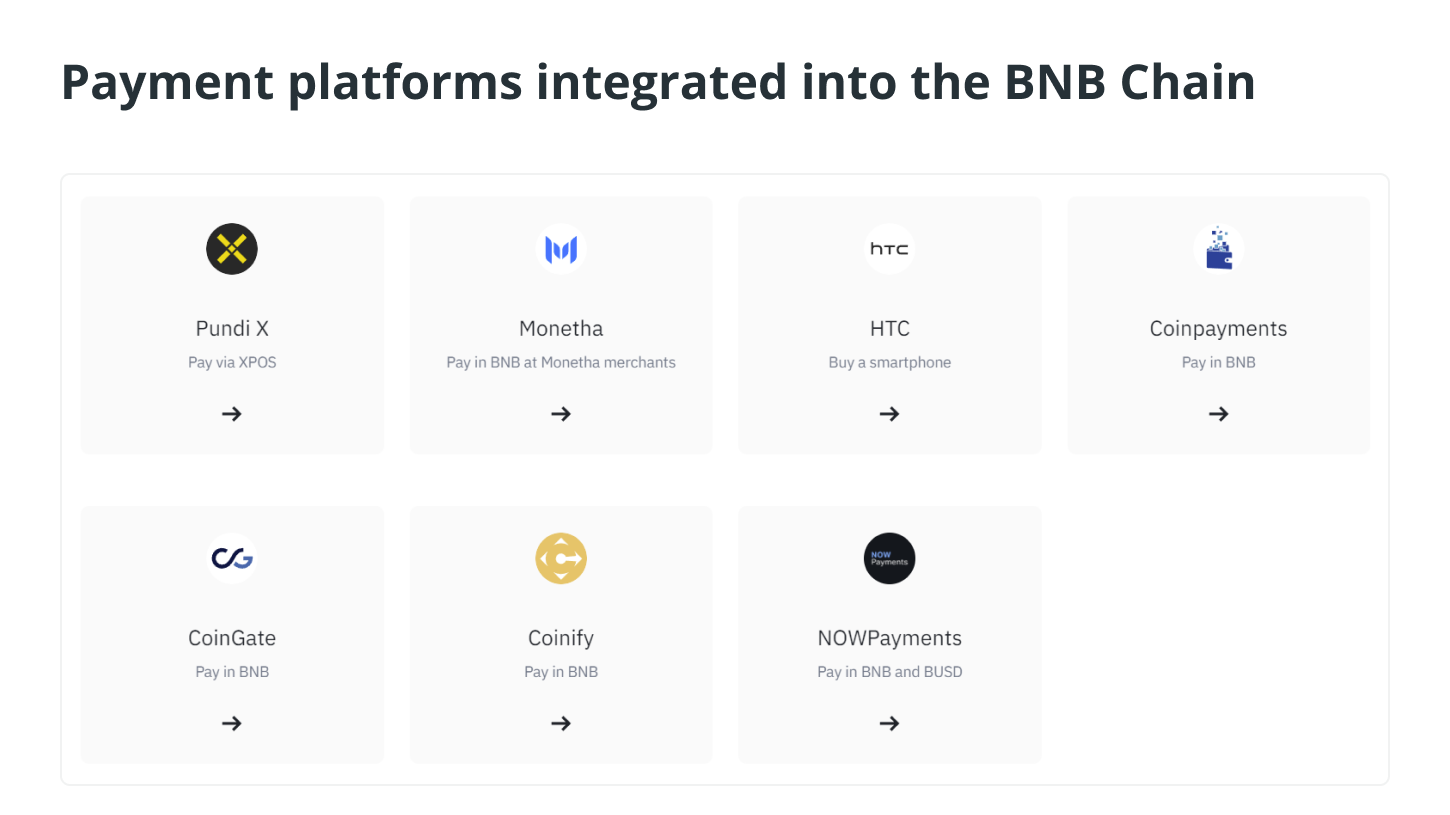 Travel
Travel
Through TravelbyBit, Trip.io, and Travala.com, you will have the ability to pay for airfare, hotel reservations, and other travel-related necessities using BNB.
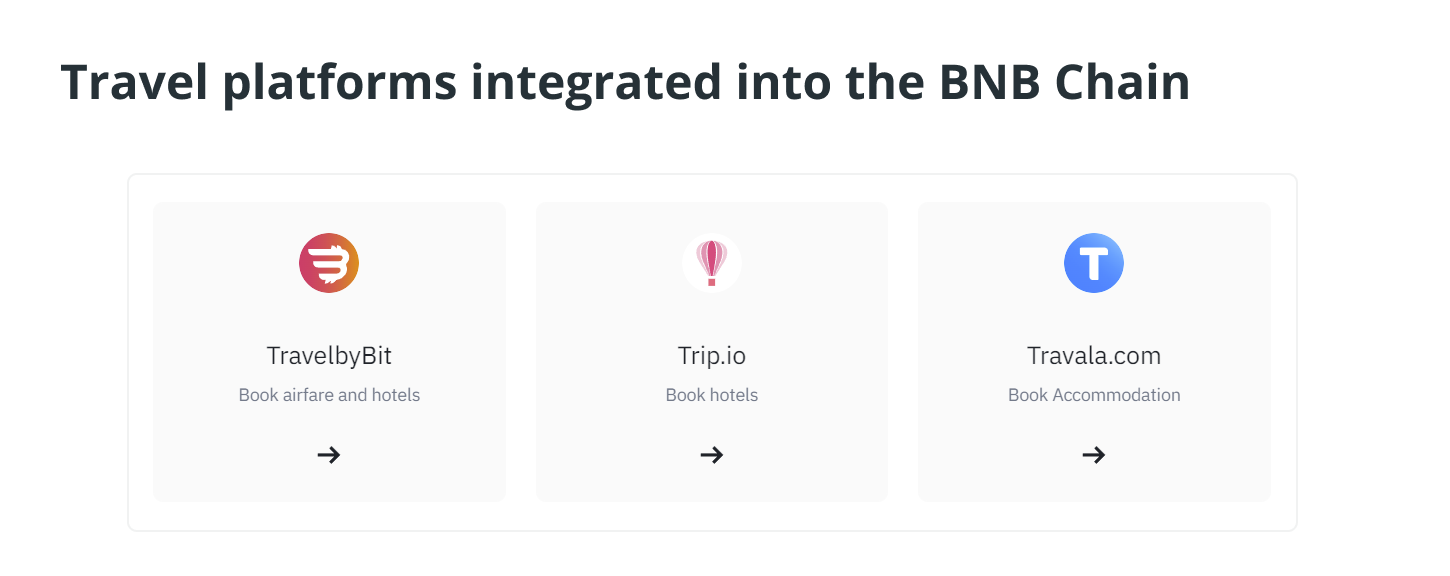 Entertainment
Entertainment
Users are able to make use of BNB on a number of integrated platforms, such as VIBE, which enables them to earn BNB from games. They also have the option of using the cryptocurrency to purchase the copyright to music through MachiX or virtual land on Axie Infinity (AXS).
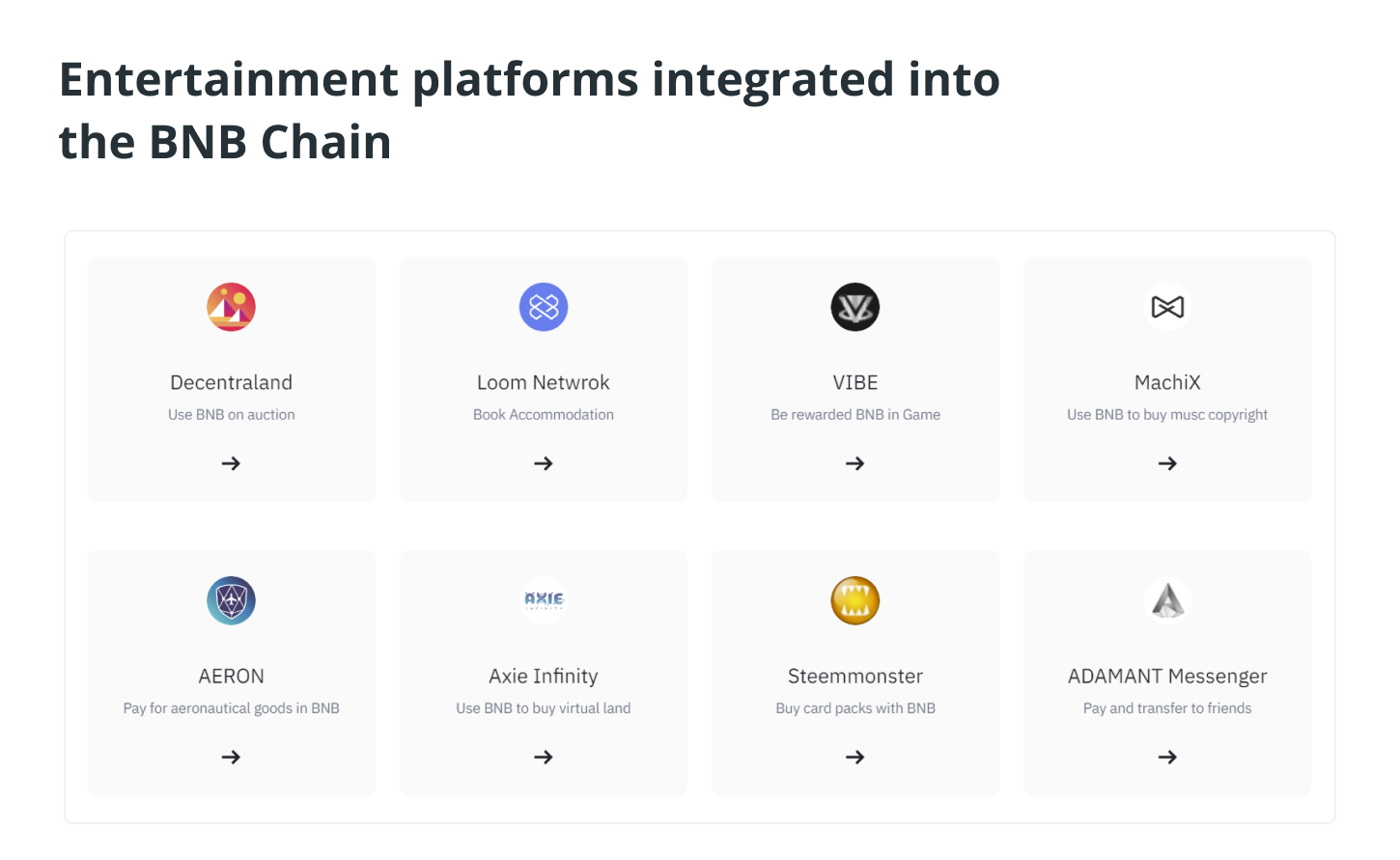 Service
Service
BNB can also be used for a wide variety of other practical purposes, such as accessing torrent sites, creating smart contracts, paying for cloud or web server subscriptions, and hiring freelancers.
 Finance
Finance
BNB can also be useful for obtaining loans, trading stocks, purchasing investments, and splitting bills and expenses with other people through the use of finance applications such as ETHLend, NAGA, Moeda, LNDR, and Nexo.
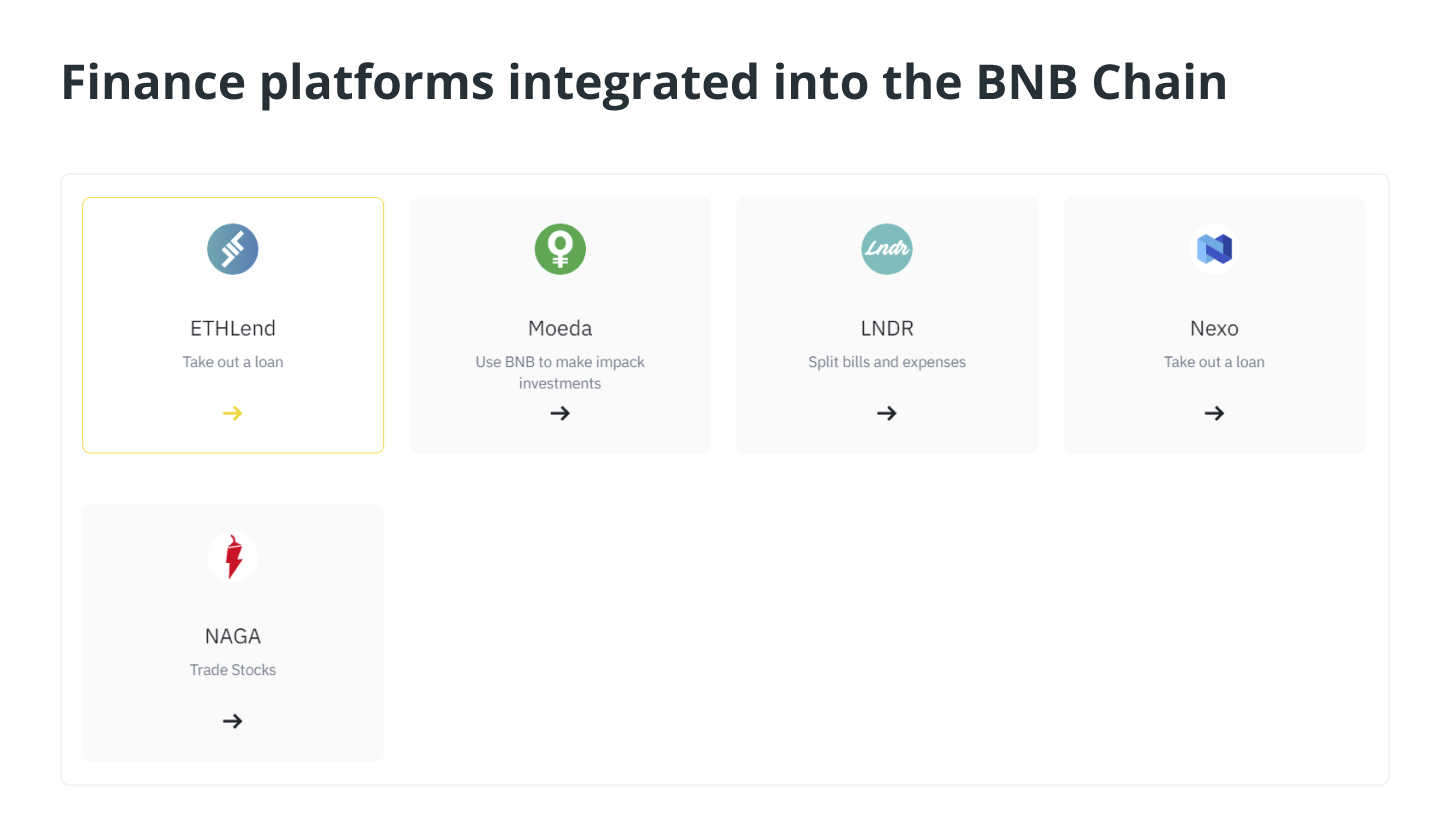 MetaFi
MetaFi
In addition, the BNB Chain is useful for the development of MetaFi.
The term “MetaFi,” which is a portmanteau of the words “meta,” which refers to the “meta ecosystem,” and “Fi,” which stands for “DeFi,” brings together under one roof a number of separate but related projects, such as Metaverse, GameFi, DeFi, Web3, SocialFi, and NFTs.
MetaFi combines a wide variety of blockchain functionalities into a single meta-ecosystem using metadata, which specifies asset ownership.
Interoperability is made possible because metadata standards are utilized consistently across all platforms and blockchains.
According to the MetaFi tagline, “Think BNB Chain, Think MetaFi,” the BNB Chain intends to facilitate innovation for MetaFi through the development of robust and interoperable projects with multichain capability and bridges to assist with the massive volume of asset and data transfers.
The community of creators, developers, and entrepreneurs can construct the infrastructure that will enable the world’s parallel virtual ecosystem to function without any interruptions if they use the BNB Chain.
The BNB Chain’s Strengths and Weaknesses
There is no application that is flawless, not even the BNB Chain. Although it has low transaction fees, rapid adoption, a bridging feature, sufficient funding, and localization, some people are concerned that the chain is centralized, has complicated and resource-consuming node operation and validation processes, and that related innovations occur on Ethereum rather than in its own environment. This is despite the fact that it offers all of these benefits and more.
The Future of BNB Chain
In addition to the increased emphasis placed on MetaFi, the BNB Chain has announced a couple of additional technological advancements that are scheduled to take place throughout the remainder of 2022. These advancements include the introduction of BSC Application Sidechains as well as new BSC partition chains.
The future is decentralised. #BSC X #Web3 pic.twitter.com/g8hEFBQ9Ba
— BNB Chain (@BNBCHAIN) January 12, 2022
This tweet by BNB Chain, which states, “The future is decentralized,” exemplifies the distinction between Web2 and Web3, as well as what Web3 means for the industry moving forward.





